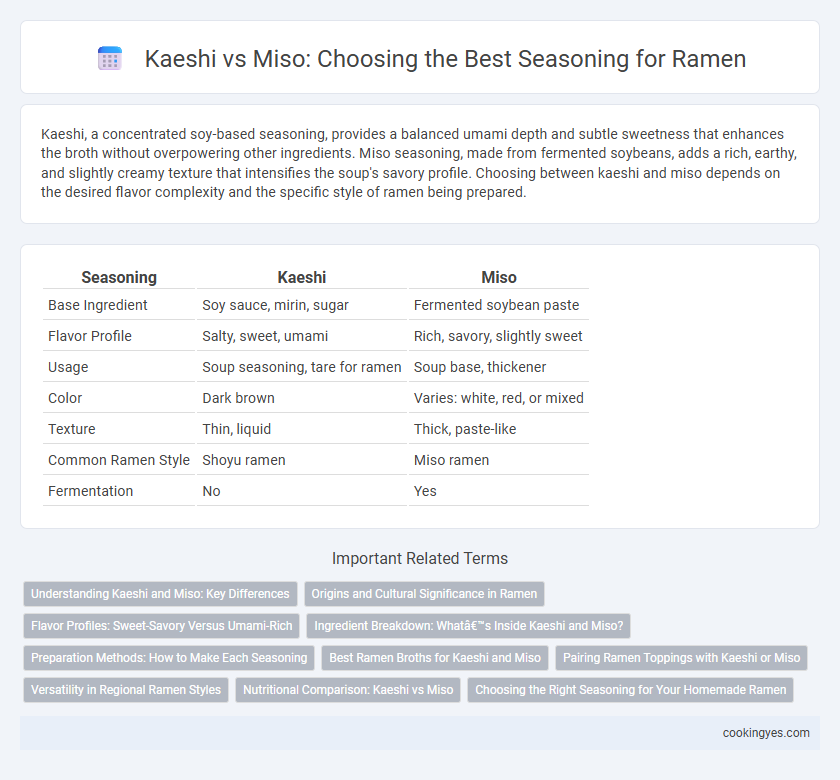Kaeshi, a concentrated soy-based seasoning, provides a balanced umami depth and subtle sweetness that enhances the broth without overpowering other ingredients. Miso seasoning, made from fermented soybeans, adds a rich, earthy, and slightly creamy texture that intensifies the soup's savory profile. Choosing between kaeshi and miso depends on the desired flavor complexity and the specific style of ramen being prepared.
Table of Comparison
| Seasoning | Kaeshi | Miso |
|---|---|---|
| Base Ingredient | Soy sauce, mirin, sugar | Fermented soybean paste |
| Flavor Profile | Salty, sweet, umami | Rich, savory, slightly sweet |
| Usage | Soup seasoning, tare for ramen | Soup base, thickener |
| Color | Dark brown | Varies: white, red, or mixed |
| Texture | Thin, liquid | Thick, paste-like |
| Common Ramen Style | Shoyu ramen | Miso ramen |
| Fermentation | No | Yes |
Understanding Kaeshi and Miso: Key Differences
Kaeshi, a concentrated seasoning blend made from soy sauce, mirin, and sugar, provides a rich umami base essential to traditional ramen broths. Miso, fermented soybean paste, imparts a complex, savory depth with a slightly tangy and earthy flavor profile, often used in miso ramen for a hearty taste. The key difference lies in Kaeshi's role as a seasoning concentrate enhancing broth balance, while Miso acts as a primary flavor agent creating distinct, robust ramen variations.
Origins and Cultural Significance in Ramen
Kaeshi, a concentrated blend of soy sauce, mirin, and sugar, originates from traditional soy sauce-based ramen in the Kanto region of Japan, embodying a savory and slightly sweet flavor essential to Tokyo-style ramen. Miso seasoning, derived from fermented soybean paste, hails from Hokkaido and reflects the region's colder climate with a rich, hearty, and umami-forward profile, making it a foundational element in Sapporo ramen. Each seasoning base carries deep cultural significance, representing regional ingredients and historical culinary practices that define distinct ramen styles across Japan.
Flavor Profiles: Sweet-Savory Versus Umami-Rich
Kaeshi seasoning offers a sweet-savory flavor profile derived from soy sauce, mirin, and sugar, balancing depth and subtle sweetness that enhances the ramen broth. Miso seasoning provides an umami-rich taste, packed with fermented soybean complexity, bringing a hearty, robust character to the soup. The choice between kaeshi and miso shapes the overall flavor, with kaeshi delivering a lighter, nuanced seasoning and miso creating a fuller, earthier richness in ramen.
Ingredient Breakdown: What’s Inside Kaeshi and Miso?
Kaeshi, a concentrated blend of soy sauce, mirin, and sugar, delivers a balanced umami and sweetness essential for tonkotsu ramen seasoning. Miso, primarily fermented soybeans combined with salt and koji mold, provides a robust, savory depth rich in probiotics and amino acids. Both seasonings offer distinct flavor profiles and nutritional components, with Kaeshi emphasizing sweet-salty harmony and Miso contributing complex fermentation-derived umami.
Preparation Methods: How to Make Each Seasoning
Kaeshi is prepared by simmering soy sauce, mirin, and sugar until slightly thickened, creating a balanced sweet and salty base for ramen broth. Miso seasoning involves fermenting soybeans with salt and koji mold over several months, then blending the resulting paste with dashi or broth to enhance umami depth. Both methods require precise temperature control and careful ingredient ratios to develop their unique flavors.
Best Ramen Broths for Kaeshi and Miso
Kaeshi, a seasoned soy sauce blend, enhances ramen broths with a balanced umami depth that complements shoyu or clear chicken-based soups, producing rich, savory flavors. Miso offers a distinctively hearty and slightly sweet profile ideal for pork or seafood broths, providing a creamy texture and robust taste. The best ramen broths for kaeshi are often light to medium-bodied chicken or vegetable stocks, while miso pairs exceptionally well with thicker, pork-based tonkotsu broths.
Pairing Ramen Toppings with Kaeshi or Miso
Kaeshi offers a balanced, soy-based seasoning that pairs well with traditional toppings like chashu pork, menma, and nori, enhancing their umami flavors without overpowering them. Miso seasoning provides a rich, hearty depth that complements robust toppings such as corn, butter, and garlic, creating a creamy and savory broth experience. Selecting kaeshi or miso depends on desired flavor intensity and topping profile, optimizing the harmony between broth and ingredients.
Versatility in Regional Ramen Styles
Kaeshi, a concentrated blend of soy sauce, mirin, and sugar, serves as a versatile seasoning base adaptable to many regional ramen styles, complementing broths from Tokyo to Kitakata with its balanced umami and sweetness. Miso, derived from fermented soybeans, imparts a richer, heartier flavor profile predominantly popular in Hokkaido ramen, enhancing the robustness of miso-based broths with its deep, savory complexity. Both seasonings influence ramen's aroma, taste, and mouthfeel, with Kaeshi providing a cleaner, lighter finish suitable for diverse styles, while miso offers a dense, earthy resonance tailored to northern regional variations.
Nutritional Comparison: Kaeshi vs Miso
Kaeshi, a concentrated seasoning made from soy sauce, mirin, and sugar, is lower in calories and fat but higher in sodium compared to miso, a fermented soybean paste rich in protein, vitamins, and probiotics. Miso provides beneficial nutrients such as vitamin B12, manganese, and zinc, contributing to digestive health through its probiotic content. Kaeshi offers a more intense umami flavor with minimal calories, while miso delivers additional nutritional benefits alongside its savory taste.
Choosing the Right Seasoning for Your Homemade Ramen
Kaeshi, a concentrated seasoning blend made from soy sauce, mirin, and sugar, provides a rich, savory depth that balances the broth's flavors without overpowering them. Miso, a fermented soybean paste, introduces a hearty, umami-packed profile with a slightly sweet and salty complexity, ideal for robust, comforting ramen varieties. Selecting between Kaeshi and Miso depends on desired flavor intensity and broth style, with Kaeshi enhancing clarity and balance, while Miso adds creamy texture and pronounced umami.
Kaeshi vs Miso for seasoning Infographic

 cookingyes.com
cookingyes.com